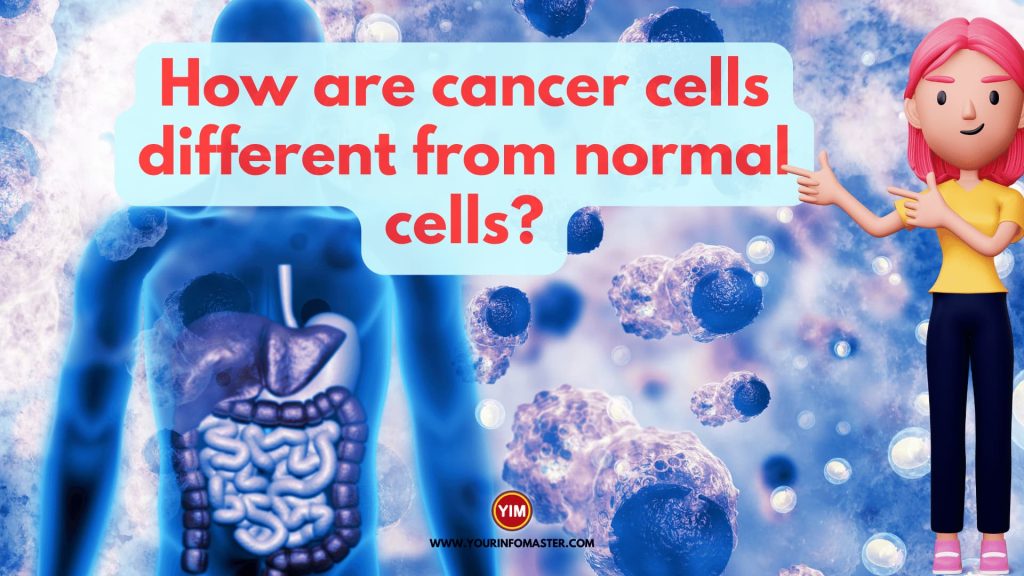I am going to explain the blog post “How are cancer cells different from normal cells?“
Cancer is a disease that affects millions of people worldwide. It occurs when normal cells in the body start to grow uncontrollably and form a mass or tumor. Cancer cells are different from normal cells in many ways, which makes them harder to control or kill. In this blog post, we will discuss the 10 key differences between cancer cells and normal cells, and how these differences impact cancer treatment and prevention.
Check also: What’s the difference between iPhone 13 and 14?
10 Differences between cancer cells and normal cells
Here is a list of 10 differences between cancer cells and normal cells:
- Introduction: How Cancer Cells Differ from Normal Cells
- Growth Rate
- DNA Changes
- Immortality
- Size and Shape
- Metabolism
- Blood Supply
- Invasion
- Anchorage-Independent Growth
- Resistance to Cell Death
Check also: What is the difference between an apostle and a disciple?
Detail of 10 Differences between cancer cells and normal cells
Cancer cells differ from normal cells in various ways. Cancer cells are abnormal cells that grow and divide faster than normal cells, and they can also spread to other parts of the body. The following are ten differences between cancer cells and normal cells:
Growth rate: Cancer cells divide and grow much faster than normal cells.
DNA changes: Cancer cells often have changes in their DNA, which can lead to uncontrolled growth.
Immortality: Cancer cells can divide indefinitely, unlike normal cells which have a limited lifespan.
Size and shape: Cancer cells can vary in size and shape, whereas normal cells have a defined shape and size.
Metabolism: Cancer cells have altered metabolic pathways, which enable them to obtain energy from different sources than normal cells.
Blood supply: Cancer cells can stimulate the growth of new blood vessels, providing them with the nutrients and oxygen they need to grow and spread.
Invasion: Cancer cells can invade surrounding tissues and organs, whereas normal cells do not invade other tissues.
Anchorage-independent growth: Cancer cells can grow without being attached to other cells or tissues, unlike normal cells.
Resistance to cell death: Cancer cells can resist programmed cell death or apoptosis, which is a natural process that eliminates damaged or abnormal cells.
Immune system evasion: Cancer cells can evade the immune system’s detection, allowing them to grow and spread undetected.
Check also: What is the difference between renewable and nonrenewable resources?
Conclusion
Cancer cells differ from normal cells in various ways, including their growth rate, DNA changes, immortality, size and shape, metabolism, blood supply, invasion, anchorage-independent growth, resistance to cell death, and immune system evasion. These differences make cancer cells more difficult to control and kill than normal cells. Understanding the differences between cancer cells and normal cells is crucial for developing effective cancer treatments and preventive measures. By targeting the unique features of cancer cells, we can develop therapies that specifically target cancer cells, leaving normal cells unharmed. Further research is needed to identify additional differences between cancer cells and normal cells, which could lead to new treatments and better outcomes for cancer patients.
See also: What’s the difference between HMO and PPO?
If you really enjoyed the article “How are cancer cells different from normal cells?,” then I would be very grateful if you’d help it spread by emailing it to your friends or sharing it on Twitter, Instagram, or Facebook. Thank you!
Have you read “How are cancer cells different from normal cells?“ Which of these blogs are you reading, and how is it similar to one of them?
Read More
- What is the difference between equity and equality?
- What is the difference between Xbox series X and S?
- What’s the difference between HMO and PPO?
- What is the difference between an apostle and a disciple?
- What’s the difference between iPhone 13 and 14?
- What is the difference between a counselor and a therapist?
- What is the difference between LPN and RN?
- Noorani Qaida Android App

